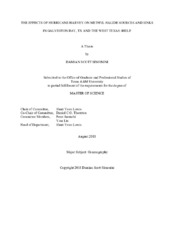| dc.description.abstract | Methyl halides, methyl chloride (CHv3Cl), methyl bromide (CHv3Br), and methyl iodide
(CHv3I), play an important role in atmospheric chemistry, because they deplete ozone through
catalytic ozone destruction. Measurements of CHv3Cl, CHv3Br, and CHv3I were made at a
combination of 14 different sampling locations in Galveston Bay during four sampling periods:
June, September, November of 2017, and March of 2018. The September measurements were
made after Hurricane Harvey had introduced over 42 billion cubic meters of water to the
surrounding area.
Over a one year period the average atmospheric concentrations for CHv3Cl, CHv3Br, and
CHv3I were 612.7ppt, 12.60ppt, and 2.35ppt, respectively. In June, CHv3Br and CHv3I
concentrations were 64% and 122% above the one year average. This significant elevation in
June concentrations were likely linked to methyl halide emissions from rice paddy production in
Arkansas. The one year average water concentrations for CHv3Cl, CHv3Br, and CHv3I were
123.1pM, 3.07pM, and 6.99pM respectively. In September, methyl halides concentrations were
lower due to a precipitation driven freshwater flushing of the bay. Correlations between the
methyl halide concentrations suggest they have a common source in the bay. Highest
concentrations of methyl halides were seen in the center of the bay with lowest near the mouth of
the Trinity River. Overall, spatial distributions of water concentrations appear to be driven by
dilution, freshwater flows into the bay by the Trinity and San Jacinto Rivers and their effects on
biological productivity. The one year average sea-to-air flux for CHv3Cl, CHv3Br and CHv3I was
28.2nmol m^-2 d^-1, 0.71nmol m^-2 d^-1, and 3.71nmol m^-2 d^-1 respectively.
Along the West Texas Shelf in October 2017, the CHv3Cl, CHv3Br, and CHv3I average water
concentrations were 140.7pM, 2.48pM, and 5.63pM and the average sea-to-air fluxes were
173.21nmol m^-2 d^-1, 2.35nmol m^-2 d^-1, 13.51nmol m^-2 d^-1 respectively. The higher sea-to-air
fluxes along the coast were partially due to overall higher saturation states, but mainly due to
higher average wind speeds during the sample period. Including emissions from coastal areas to
overall global ocean emission predictions could elevate the global ocean emission source by
12.5% and 4.2% for CHv3Cl and CHv3Br respectively. | en |


